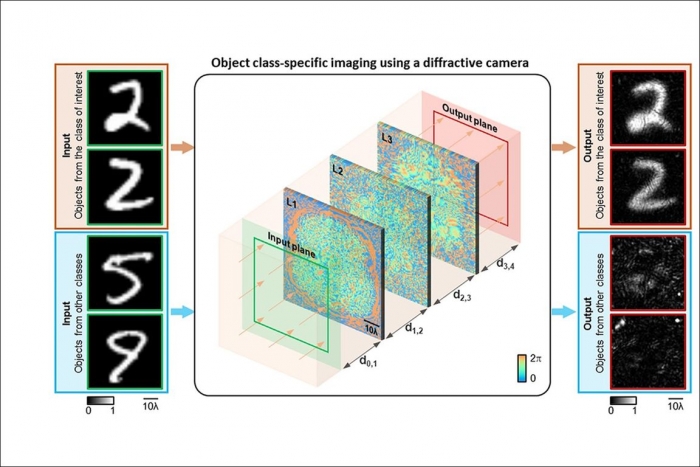 University of California, Los Angeles
University of California, Los Angeles
- Written by Moderator
Privacy-preserving camera captures only the objects you want
Energy-efficient AI imaging technology developed by UCLA engineers works before a photo is snapped. In the diagrammatic example, the camera’s diffractive layers (colored surfaces in the middle) were custom-designed to recognize the handwritten number “2” but diffract light from other numbers, turning it into background noise.
Over the past decade, digital cameras have become ubiquitous in modern life — embedded in smartphones, smart eyewear, security surveillance systems, autonomous vehicles and facial recognition technologies. And as the sheer amount of image data being captured has grown, so have concerns about privacy protection. In a paper recently published in the journal eLight, a team of researchers from the UCLA Samueli School of Engineering describe an artificial intelligence–informed smart camera that instantly captures only the objects of relevance in a frame while simultaneously blotting out unnecessary or potentially sensitive details, without the need for any editing, encryption or other digital post-processing work. Their device consists of several transmissive, 3D-printed surfaces (see image above), each composed of tens of thousands of diffractive features at the scale of the wavelength of light. The team used deep learning–based training to design and assemble the successive layers.
“We’d like to design a robust, power-efficient and secure smart camera that can safeguard privacy by controlling what a camera lens sees and captures before one clicks the shutter,” said lead researcher Aydogan Ozcan, the Volgenau Professor for Engineering Innovation at UCLA Engineering.
The research results are published in this article.
Read the full article at UCLA News.
Visible Legacy Comment
The technology is still in its early stages, its potential to erase sensitive information at the point of capture could eliminate the risk of hacking or the exposure of original, unedited versions of images, especially those stored in the cloud. At the same time, it removes the need for any after-the-fact processing, which is data-intensive and consumes more power. The Lab in Electrical and Computer Engineering has recently collaborated with the Department of Chemistry and Biochemistry to make public a technology for license "Optoelectronic Neuron Array for Nonlinear Optical Modulation and AI Cameras" that is a novel optoelectronic neuron array for computational imaging and sensing applications that can work under weak broadband incoherent light. Corporate Licensing Professionals seeking to advance embedded in smartphones, smart eyewear, security surveillance systems, autonomous vehicles and facial recognition technologies applications may want to explore this ecosystem in Visible Legacy Navigator below.
Additional Info
-
Navigator:
 Explore the map in Navigator
Explore the map in Navigator - Widget:
- Caption: UCLA Aydogan Ozcan and Xiangfeng Duan technology context
Related items
- The future of health care is in our cells
- Federal funding will help WSU professor develop technology to recover rare earth elements
- Unlocking the brain: Peptide-guided nanoparticles deliver mRNA to neurons
- Scientists Get to the Bottom of COVID’s Worst Pediatric Complication
- WSU-inspired national gene-editing task force begins work
